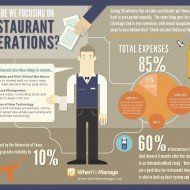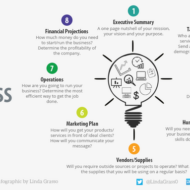Posted by Managementguru in Business Management, Entrepreneurship, How To, Marketing, Project Management, Startups
on Jan 5th, 2015 | 0 comments

Startup Business Plan for a Restaurant The success of any business, start with a good and efficient plan and this is true in the case of food service trades like restaurants. Generally, Startup food business planning for a restaurant should begin with an executive summary, which will give a summary or overview of the entire business plan. This can act as a blueprint towards guiding entrepreneurs from the initial stages to the first 3-5 years of operation. This plan will document each and every detail about the operation of the restaurant. We find the following article comprehensive and resourceful on “Great ideas for your restaurant.” Source: ALSCO.COM … Read on… http://www.alsco.com.au/2017/02/restaurant-business-plan-strategies/ Executive summary: When a professional Food service franchise business consultant is asked, the professional will suggest that the executive summary will identify how much financing will be needed to begin with the operations. It will also specify the funding needed until the food business begins to show up profits. Experts are of the opinion that income projections for the first three to five years should also be present in this summary. This part should also encompass a description of the proposed restaurant that identifies the unique aspects of the operation. Another great post on “Starting a Coffee Shop“, by Anna Kucirkova brings you concrete ideas needed to open a comfy coffee shop to rake in profits. Starting A Coffee Shop? Here’s What You Need To Know Restaurant Marketing – The Basics Concept: Professional food service franchise business consultant will also suggest that the concept, theme and the type of cuisine to be served in the restaurant and the important components that should be documented in detail in the food service startup plan. Here, the location of the restaurant should be identified. Startup expenses: In the process of startup food business planning, it is important that appropriate plan must be documented for anticipated expenses. Generally, there will be startup costs associated with the establishment of the restaurant and it will of course include one-time expenses like purchase of furniture, commercial kitchen equipment, building alterations and initial construction. In addition, other startup expenses include glassware, table linens, theme-compatible table settings, etc… Apart from these expenses, there will be administrative costs like permission from health department, business licensing fee, etc… Budgets: When it comes to preparing budgets, the costs for initial setup should be identified. Here, both fixed and variable expenses should be identified. Fixed expenses include those that are the same each month like lease payments. Variable expenses include regular menu items, whose cost will vary as per season. There are professional consultants, who can help people planning to start any type of food-related trades like a food truck business. They can give the appropriate suggestion for framing a food truck business plan. They are of the opinion that the some of the above-mentioned items like budget and startup expenses should be included in the process of the food truck business plan. Related Posts: The Viability of Running a Restaurant What is a Startup Cost? Article Source: Startup Business Plan For A...

Posted by Managementguru in Business Management, Organisational behaviour, Principles of Management
on Mar 2nd, 2014 | 0 comments

Your business structure will affect a lot of factors – You can start with an initial business structure and change it as your business thrives. But first and foremost you need a solid business plan that details your mission, vision and purpose. These 7 steps in planning will guide you through and give your project a headstart. The business plan cheatsheet is given in a pictorial form for your benefit. ☝️ A. Opportunity Analysis: SWOT analysis– the analysis of strength and weaknesses, opportunities and threats in the external environment is the first and foremost step in planning. The target market, competitor strength, internal weaknesses, customer’s preferences are some of the key areas to be focused. B. Setting objectives: Where we want to be, and what we want to accomplish and when are answered in this step. Each and every employee of the organization has to be apprised about the enterprise objectives in order to achieve the expected or desired result. Management by objectives is one of the proven methods where-in the objectives are set by the subordinates themselves under the guidance of their superior and periodical reviews are conducted to check whether the set objectives are accomplished within the stipulated time. C. Developing Premises: The critical factors that affect the planning process are analyzed thoroughly. Say, government policies, business cycle trends, economic indicators, inflation, tax rates etc are analyzed and the plans are developed based on these premises. D. Identifying Alternatives: It is better to have an alternate plan or plans which helps in deciding the alternate course of action. Alternatives identification is a technique used for identifying different methods or ways of accomplishing the work of the project. For example, brainstorming might be used to discover alternative ways of achieving one of the project objectives. E. Evaluating Alternatives and selecting the suitable plan: The limiting factors can be set as a criterion for evaluating the alternatives. The limiting factors may be cost, time, manpower and other resources. Operations research helps in the assessment of alternatives and selecting the best. Think about this, if plan A fetches you more profit but proves to be expensive and plan B fetches you consistent profit and less expensive, what will be your choice? Even banks look into the fund flows of different projects submitted by clients and select the ones that proves to fetch consistent returns on the long run. F. Formulating Supportive plans: Download this Business Planner Printable which comes in handy when you want to weigh your choices👇 Business-Journal-Planner-1Download Derived plans are those that stem from the main ones that support the basic plan. Recruiting and inducting may be the basic plan of a HR department but training and development is the supporting plan that gives shape to the basic plan. G. Developing Budgets: Budget is referred in financial terms and they are required to control plans. There is always a constraint for resources and hence it is the responsibility of a manager to decide on the investment in a particular plan that will tide away the risk of the...




